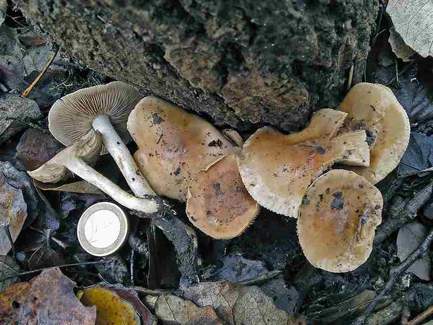 Hebeloma matritense (Photo: L. Ballester)
Hebeloma matritense (Photo: L. Ballester)Taxonomy
Full name: Hebeloma matritense Beker, Vesterh. & U.Eberh., Fungal Biol. 120: 86 (2015) ["2016"]Genus: Hebeloma
Section: Denudata
Subsection: Clepsydroida
Types: SPAIN: Madrid, Parque Regional del Sureste, near Jarama river, near road A-3, km 20-22 between villages Vaciamadrid and Arganda. (40.3185°N, 3.498°W, alt. approx. 550 m a.s.l.) on calcareous, decomposed, sandy soil and litter in Mediterranean woodland under Populus nigra and Populus sp., 11 Nov. 2003, A. Andrews, det: H.J. Beker (Holotype. herbarium acc. no. BR-MYCO 174910-19 (holotype), C-F-92310 (isotype), HJB9485).
- arrow_drop_downarrow_drop_upEtymologyCurrently this species is known from only one location: near Madrid in Spain.
- arrow_drop_downarrow_drop_upDiagnosisHebeloma matritense possesses the cheilocystidia typical of H. subsect. Clepsydroida. The spore length of less than 12.5 µm and the number of entire lamellae, greater than 70, readily distinguish this species from H. vaccinum and H. ammophilum, which are most similar. The ITS of both known collections is clearly distinct from the ITS sequences of all other Hebeloma species for which ITS data are available.
References
Description
- arrow_drop_downarrow_drop_upThresholds
Description of Hebeloma matritense based on 4 collections
- arrow_drop_downarrow_drop_upMacroscopic descriptionPileus: (16) 20–44 (52) mm diameter; shape often umbonate, occasionally convex; characters Not recorded; margin characters occasionally crenulate, eroded or involute; viscosity tacky when moist; colour variation two color; colour at centre often orange-brown, occasionally yellowish brown or cinnamon.
Lamellae: attachment emarginate; maximum depth up to 3 mm; number of complete lamellae 40–78; presence of tears often visible with x10 lens, occasionally visible with naked eye; white fimbriate edge often present or weak.
Cortina presence: no.
Stipe: (40) 45–72 (89) x 3–8 (10) {median} x 3–8 (10) {basal} mm; stipe Q 6.0–15.0; base shape cylindrical, often clavate; floccosity often floccose or pruinose at apex, occasionally weakly floccose; rooting no; thick rhizoids at base absent;
Context: Texture firm; stipe interior hollow, occasionally stuffed; stipe flesh discolouring variable; slenderness measure 9.1–39.8; smell raphanoid, occasionally cocoa; taste raphanoid where recorded.
Spore deposit colour: Not recorded.
Exsiccata characters: often fragile or pileus blackening.
- arrow_drop_downarrow_drop_upMicroscopic descriptionSpores: shape amygdaloid, often limoniform; colour in microscope yellow brown; guttules often yes or weak. papilla yes; Spore Code: (O2) O3; P1 P2; D2 D3.
Basidia: (23) 24–35 x 6–9 μm; ave. Q 3.5–4.1; spore arrangement 4 spored;
Cheilocystidia: main shape clavate-lageniform or clavate-ventricose, occasionally capitate or clavate; special features observed often geniculate or septa, occasionally apical thickening or median thickening; cheilocystidia ratios: A/M = 1.61–1.77; A/B = 1.09–1.32; B/M = 1.40–1.68.
Pleurocystidia: none seen.
Ixocutis: epicutis thickness (measured from exsiccata) up to 60 μm; ixocutis hyphae width up to 6 μm; ixocutis hyphae encrustation yes; shape of trama elements beneath subcutis often thickly sausage-shaped, occasionally cylindrical or thinly sausage-shaped up to 20 μm wide.
Caulocystidia: Similar to cheilocystidia but larger, up to 60 μm.
- arrow_drop_downarrow_drop_upSpore measurements
- arrow_drop_downarrow_drop_upCheilocystidia measurements
- arrow_drop_downarrow_drop_upHabitat and distributionHebeloma matritense's preferred habitat appears to be Mediterranean woodland, woodland or deciduous woodland with calcareous, decomposed, sandy soil and litter, calcareous, decomposed soil and litter or litter. Where only one possible associate was recorded, that associate has always been Populus (family Salicaceae). We have additional records where Quercus, Carpinus and Salix were recorded as possible associates, but in these cases a number of possible associates were mentioned. Overall the most commonly recorded families are Salicaceae (100.0%), Fagaceae (25.0%) and Betulaceae (25.0%) The growth habit of our collections was scattered.
According to our current collections, the species is found only in Europe. On the continent, collections have been found only in the mediterranean forests, woodlands & scrub WWF biome The World Wildlife Fund (WWF) have divided the world into 867 terrestrial ecoregions. The ecoregion here is estimated by mapping from the GPS coordinates of the collection using data made available by Dinerstein et al (2017). Use this webtool to explore the ecoregions visually or see a full list of current ecoregions on Wikipedia. (Iberian sclerophyllous and semi-deciduous forests (75.0%) and Italian sclerophyllous and semi-deciduous forests (25.0%) ecoregions). From collector information, it appears collections have been found only in the 1.4 Forest – Temperate IUCN habitat We map from the collector's description of the habitat to the International Union for Conservation of Nature (IUCN)'s definition using a standardised set of rules. Please see this page for a full list of IUCN habitats.. Within Europe we have records from the Southwest (Spain) and the Southeast (Italy). Specimens have been collected from 40.3°N to 42.1°N.
- arrow_drop_downarrow_drop_upMolecular resultsHebeloma matritense is molecularly clearly distinct and sequences from the two available collections form highly supported clades in the phylogenetic results of all single loci, separately and concatenated. There are no other ITS sequences published that are likely to belong to this taxon.
- arrow_drop_downarrow_drop_upCommentaryGiven the shape of its cheilocystidia, Hebeloma matritense clearly belongs to H. sect. Denudata subsect. Clepsydroida. The species was most likely not included in the intercompatibility tests of Aanen & Kuyper (1999). The pileus colour, distinctly orange brown in the centre and its spores, many strongly dextrinoid and with average width greater than 6.5 μm place it in a group including H. ammophilum and H. vaccinum, both of which are confined to Salicaceae. The spore length < 12.5 μm and the number of lamellae, L > 65, readily distinguish it from these two species. Without more collections, it is difficult to be sure about either the geographical distribution of this species or whether it is confined to Salicaceae and soil with a relatively high pH. We await further collections. We note that this site has been revisited a number of times by Francisco de Diego Calonge since the original collections were made; until now it has not been refound.
Geographic distribution
Phenology
- arrow_drop_downarrow_drop_upAdditional cited collections